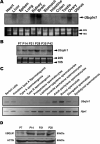UBQLN1 interacts with SPEM1 and participates in spermiogenesis
- PMID: 20558241
- PMCID: PMC2950875
- DOI: 10.1016/j.mce.2010.06.006
UBQLN1 interacts with SPEM1 and participates in spermiogenesis
Abstract
Spermiogenesis represents the process through which haploid male germ cells differentiate from round spermatids into elongated spermatids and eventually the male gametes called spermatozoa. Haploid cell differentiation is unique to male germ cell development and many unique genes/proteins essential for this process have been discovered. SPEM1 is one of these spermiogenesis-essential proteins encoded by a testis-specific gene exclusively expressed in the developing spermatids. Inactivation of Spem1 in mice results in deformed spermatozoa characterized by "head-bent-back" abnormalities with 100% penetrance. Using yeast two-hybrid screening assays, we identified UBQLN1 as one of the SPEM1-interacting partners. UBQLN1 and SPEM1 were colocalized to the manchette of elongating spermatids. Since UBQLN1 functions through binding and directing poly-ubiquitinated proteins to the proteasome for degradation, interactions between UBQLN1 and SPEM1 suggest a role in the regulation of protein ubiquitination during spermiogenesis.
Copyright 2010 Elsevier Ireland Ltd. All rights reserved.
Figures







Similar articles
-
RANBP17 is localized to the XY body of spermatocytes and interacts with SPEM1 on the manchette of elongating spermatids.Mol Cell Endocrinol. 2011 Feb 20;333(2):134-42. doi: 10.1016/j.mce.2010.12.021. Epub 2010 Dec 22. Mol Cell Endocrinol. 2011. PMID: 21184802 Free PMC article.
-
Lack of Spem1 causes aberrant cytoplasm removal, sperm deformation, and male infertility.Proc Natl Acad Sci U S A. 2007 Apr 17;104(16):6852-7. doi: 10.1073/pnas.0701669104. Epub 2007 Apr 10. Proc Natl Acad Sci U S A. 2007. PMID: 17426145 Free PMC article.
-
The mouse transcription factor-like 5 gene encodes a protein localized in the manchette and centriole of the elongating spermatid.Andrology. 2013 May;1(3):431-9. doi: 10.1111/j.2047-2927.2013.00069.x. Epub 2013 Feb 27. Andrology. 2013. PMID: 23444080
-
Spermatogenesis in mammals: proteomic insights.Syst Biol Reprod Med. 2012 Aug;58(4):179-90. doi: 10.3109/19396368.2012.691943. Syst Biol Reprod Med. 2012. PMID: 22788530 Review.
-
Haploid male germ cells-the Grand Central Station of protein transport.Hum Reprod Update. 2020 Jun 18;26(4):474-500. doi: 10.1093/humupd/dmaa004. Hum Reprod Update. 2020. PMID: 32318721 Review.
Cited by
-
SPEM1 Gene Mutation in a Case with Sperm Morphological Defects Leading to Male Infertility.Reprod Sci. 2024 Oct;31(10):3102-3111. doi: 10.1007/s43032-024-01612-w. Epub 2024 Jun 17. Reprod Sci. 2024. PMID: 38886283
-
Incomplete cre-mediated excision leads to phenotypic differences between Stra8-iCre; Mov10l1(lox/lox) and Stra8-iCre; Mov10l1(lox/Δ) mice.Genesis. 2013 Jul;51(7):481-90. doi: 10.1002/dvg.22389. Epub 2013 Mar 30. Genesis. 2013. PMID: 23554062 Free PMC article.
-
Genetic etiological spectrum of sperm morphological abnormalities.J Assist Reprod Genet. 2024 Nov;41(11):2877-2929. doi: 10.1007/s10815-024-03274-8. Epub 2024 Oct 17. J Assist Reprod Genet. 2024. PMID: 39417902 Review.
-
The ubiquilin gene family: evolutionary patterns and functional insights.BMC Evol Biol. 2014 Mar 28;14:63. doi: 10.1186/1471-2148-14-63. BMC Evol Biol. 2014. PMID: 24674348 Free PMC article.
-
SEPT12-microtubule complexes are required for sperm head and tail formation.Int J Mol Sci. 2013 Nov 7;14(11):22102-16. doi: 10.3390/ijms141122102. Int J Mol Sci. 2013. PMID: 24213608 Free PMC article.
References
-
- Andersen KM, Hofmann K, Hartmann-Petersen R. Ubiquitin-binding proteins: similar, but different. Essays Biochem. 2005;41:49–67. - PubMed
-
- Chai Y, Berke SS, Cohen RE, Paulson HL. Poly-ubiquitin binding by the polyglutamine disease protein ataxin-3 links its normal function to protein surveillance pathways. J Biol Chem. 2004;279:3605–3611. - PubMed
-
- Clermont Y. Kinetics of spermatogenesis in mammals: seminiferous epithelium cycle and spermatogonial renewal. Physiol Rev. 1972;52:198–236. - PubMed
-
- Cole A, Meistrich ML, Cherry LM, Trostle-Weige PK. Nuclear and manchette development in spermatids of normal and azh/azh mutant mice. Biol Reprod. 1988;38:385–401. - PubMed
-
- Conklin D, Holderman S, Whitmore TE, Maurer M, Feldhaus AL. Molecular cloning, chromosome mapping and characterization of UBQLN3 a testis-specific gene that contains an ubiquitin-like domain. Gene. 2000;249:91–98. - PubMed
Publication types
MeSH terms
Substances
Grants and funding
LinkOut - more resources
Full Text Sources
Molecular Biology Databases

